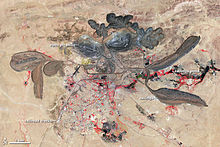稀土礦物


稀土礦物(英語:Rare earth mineral)是指主要成分包含一種或是多種稀土元素的礦物。稀土礦物通常發現於鹼性至過鹼性火成岩組合中、與鹼性岩漿伴生的偉晶岩中,或是存在/伴生於碳酸鹽深成岩中。[1]具有鈣鈦礦結構的礦物是稀土元素鹼性錯合物的常見宿主。[2]來自地幔的碳酸鹽熔體也是稀土的載體。[3]與鹼性岩漿作用相關的熱液礦床含有多種稀土礦物。[1]
而稀土元素是一組共17種,銀白色、質軟、具有光澤,但彼此性質相似難以區別的金屬元素。[4][5] 雖然名為稀土元素,但實際上這些元素在地殼中的數量相對豐富,其中豐度最高的鈰是地殼中排名第25常見的元素(參見地殼元素豐富度列表),佔68百萬分率,含量超過銅。然而,由於稀土元素的地球化學特性,它們在地殼中分布通常十分分散,而罕有富集到高濃度的稀土礦物存在,因此世界上少有具開採價值的礦場,故得「稀土」之名。[6]
中國的儲藏量佔全世界的36.7%,[7]但中國的產量曾佔全世界的95%以上,[8]在2017年佔全世界的81%。到2021年中國的產量佔全世界的60.63%,而同年美國的產量排名第2,佔比為15.52%。[9]
中國的白雲鄂博礦區是世界已知最大的稀土礦物蘊藏區。[10]在2005年,這個礦區的稀土元素產量曾高達全世界的45%。[11][12][13]
常見稀土礦物
[编辑]以下所列的是比較常見的熱液稀土礦物,以及經常含有顯著稀土元素替代物的礦物:[14]
開採作業對環境的可能影響
[编辑]在自然環境中的稀土元素濃度非常低。蘊藏這類資源的礦山通常位於環境和社會標準非常低的國家,因為礦山的開發,而導致有侵犯人權、森林砍伐的事情,並且污染到當地的土地和水源。[15][16]
在採礦和工業生產場所附近,稀土元素的濃度會上升到正常背景水準的許多倍。稀土元素一旦進入環境,就會滲入土壤中,然後它們的遷移取決於多種因素,例如侵蝕作用、風化作用、pH值、降水和地下水等。如同金屬一樣,它們可根據土壤條件形成,無論是移動,或是被吸附到土壤顆粒中。根據它們的生物利用度,稀土元素可被植物吸收,然後被人類和牲畜攝入。對於稀土元素的開採,使用( 肥料添加劑)和磷肥的生產,都會導致稀土元素污染 。[17]此外,在萃取稀土元素的過程中會用到強酸,而這些酸會滲入環境,並通過水體而導致水生環境酸化。
對於稀土元素的開採、提煉和回收,如果管理不當,會對環境造成嚴重後果。稀土元素尾礦中的釷和鈾因有低放射性,而存有潛在危害,[18]這些物質如果處理不當,會對環境造成廣泛的傷害。
參見
[编辑]參考文獻
[编辑]- Jones, Adrian P., Francis Wall and C. Terry Williams, eds. (1996) Rare Earth Minerals: Chemistry, Origin and Ore Deposits, The Mineralogy Society Series #7, 372 pp. ISBN 978-0-412-61030-1
- ^ 1.0 1.1 Dostal, Jaroslav. Rare Metal Deposits Associated with Alkaline/Peralkaline Igneous Rocks. ResearchGate. April 2016. doi:10.5382/Rev.18.02.
- ^ Campbell, Linda S; Henderson, Paul. Rare Earth Chemistry of Perovskite Group Minerals from the Gardiner Complex, East Greenland. Mineralogical Magazine. April 1997, 61 (405): 1970212. doi:10.1180/minmag.1997.061.405.04.
- ^ Yaxley, Gregory M.; Sujoy Ghosh, Sujoy. Deep Carbon. 6 - CO2-Rich Melts in Earth: Cambridge University Press. : 129 - 162 [2022-06-20]. (原始内容存档于2022-06-27).
They are also of particular economic importance as hosts or sources of many critical metals, including the rare earth elements (REEs) Nb, Ta, P, and others.
- ^ Professor of Chemistry at University College London, Andrea Sella, YouTube上的Andrea Sella: "Insight: Rare-earth metals", Interview on TRT World / Oct 2016, minutes 4:40 - ff.
- ^ T Gray. Lanthanum and Cerium. The Elements. Black Dog & Leventhal. 2007: 118–122.
- ^ Haxel G.; Hedrick J.; Orris J. Rare Earth Elements—Critical Resources for High Technology (PDF). Edited by Peter H. Stauffer and James W. Hendley II; Graphic design by Gordon B. Haxel, Sara Boore, and Susan Mayfield. United States Geological Survey. 2002 [2012-03-13]. USGS Fact Sheet: 087‐02. (原始内容 (PDF)存档于2010-12-14).
However, in contrast to ordinary base and precious metals, REE have very little tendency to become concentrated in exploitable ore deposits. Consequently, most of the world's supply of REE comes from only a handful of sources.
- ^ Suzanne Goldenberg. Rare earth metals mine is key to US control over hi-tech future: Approval secured to restart operations, which could be crucial in challenging China's stranglehold on the market. The Guardian (London). 26 December 2010 [2022-06-20]. (原始内容存档于2022-06-14).
- ^ Tse, Pui-Kwan. USGS Report Series 2011–1042: China's Rare-Earth Industry. pubs.usgs.gov. [2018-04-04]. (原始内容存档于2022-01-20).
- ^ Distribution of rare earths production worldwide as of 2021, by country. statista. 2022-03-04 [2022-06-12]. (原始内容存档于2022-06-08).
- ^ Rare Earths: The Hidden Cost to Their Magic" (Part 2), Distillations Podcast and transcript, Episode 242. Science History Institute. June 25, 2019 [2019-08-28]. (原始内容存档于2019-08-03).
- ^ Lawrence J. Drewa, Meng Qingrunb and Sun Weijun. The Bayan Obo iron-rare-earth-niobium deposits, Inner Mongolia, China. Lithos. 1990, 26 (1–2): 43–65. doi:10.1016/0024-4937(90)90040-8.
- ^ Xue-Ming Yang, Michael J. Le Bas. Chemical compositions of carbonate minerals from Bayan Obo, Inner Mongolia, China: implications for petrogenesis. Lithos. 2004, 72 (1–2): 97–116. doi:10.1016/j.lithos.2003.09.002.
- ^ Chengyu Wu. Bayan Obo Controversy: Carbonatites versus Iron Oxide-Cu-Au-(REE-U). Resource Geology. 2007, 58 (4): 348–354. doi:10.1111/j.1751-3928.2008.00069.x. (原始内容存档于2012-12-17).
- ^ Rare element substitution a tricky proposition. CHEMISTRYWORLD. 2014-01-06 [2022-01-07]. (原始内容存档于2022-03-23).
- ^ Rizk, Shirley. What colour is the cloud?. European Investment Bank. 2019-06-21 [2020-09-17]. (原始内容存档于2021-04-14) (英语).
- ^ Standaert, Michael. China Wrestles with the Toxic Aftermath of Rare Earth Mining. Yale Environment 360. Yale School of the Environment. 2019-07-02 [2021-06-16]. (原始内容存档于2022-07-09).
- ^ Volokh, A. A.; Gorbunov, A. V.; Gundorina, S. F.; Revich, B. A.; Frontasyeva, M. V.; Chen Sen Pal. Phosphorus fertilizer production as a source of rare-earth elements pollution of the environment. Science of the Total Environment. 1990-06-01, 95: 141–148. Bibcode:1990ScTEn..95..141V. ISSN 0048-9697. PMID 2169646. doi:10.1016/0048-9697(90)90059-4 (英语).
- ^ Bourzac, Katherine. "Can the US Rare-Earth Industry Rebound?" (页面存档备份,存于互联网档案馆) Technology Review. 2010-10-29.
外部連結
[编辑]| 外部媒体链接 | |
|---|---|
| 音频 | |
| 视频 | |
